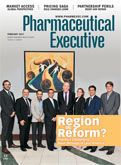When You Need Experts, Use Them
Pharmaceutical Executive
Here's to hoping that PhRMA's new public education campaign advances the voice of the patient in its messaging.
"Surround yourself with people smarter than you,” is attributed to businessman Russell Simmons. Sometimes, when you are starting a new profession, or prepping for a new sports team, or maybe if you are a seasoned veteran coming against a new problem, it can serve you well to seek sound advice. I have a big job filling my predecessor’s shoes. Though I’m an editorial veteran, this side of pharma is one I’ve only watched from afar as Editor for Applied Clinical Trials. But if there is one thing I know is that you have to surround yourself with smart people. I’ve done that
Lisa Henderson

for years at ACT. Our Editorial Advisory Board, as well as regular contributors and internal colleagues are my go-to experts.
The Editorial Advisory Board is the saving grace of our fine reputation and second to none in providing guidance, leadership and insight to our content direction.
The Pharmaceutical Executive Editorial Advisory Board members have been graciously acclimating me to the current and future environment that shapes “this side” of pharma. The executives in the C-suite and just below the suite, that need to keep up on pricing and reimbursement, market access, technology solutions, strategy, portfolio decisions, marketing, launches and so much more. Their expertise is formidable and more than helpful.
In this month’s Roundtable on Latin American access, Christopher Ngai, Global Market Access Lead, Late-Stage Oncology Assets, Bayer, said, “I think our industry highlights often its contribution toward advancing science and care for patients and improving lives. Clinical research is the bread and butter of our business model. It takes a significant investment to undertake clinical trials.”
On the clinical trials side, organizations have highlighted the need for study participants, and are actively seeking ways to educate physicians and patients on the clinical trials process. On the other hand, the industry as a whole doesn’t seem to have a coherent investment or system to bring attention to those contributions in advancing science as Ngai mentioned.
But that seems to be changing as PhRMA announced late in January an advertising and public affairs campaign. Named GOBOLDLY, it “will showcase the industry’s unsung heroes driving cutting-edge advances in science and highlight the tremendous opportunity that exists to tackle our most complex and devastating health conditions.”
While PhRMA has offered previous campaigns, most recently “From Hope to Cures,” featuring positive patient stories, this direct-to-consumer initiative is broader. It includes TV, print, digital, radio and out-of-home advertising, in a three-year campaign, which highlights the following three distinct initiatives:
- The New Era of Medicine: An initiative convened by the scientists at America’s biopharmaceutical companies to foster a national dialogue on bold advancements in science.
- The Value Collaborative: An effort to engage stakeholders across the healthcare system to advance policy solutions that will enable the private sector to lead the move to a value-driven healthcare system.
- Public Health: A public outreach and education campaign around critical public health issues facing America today.
If nothing else, the members of PhRMA are acknowledging they need an image improvement after the EpiPen and Martin Shkreli public opinion disasters of last year. But in reality, pharma has long suffered from a public perception problem. In 1998, the industry scored high in a Harris Interactive Poll. But by 2004, that 73% dropped to 44%. In the most recent 2016 Gallup Poll, the pharmaceutical industry was second to last in public opinion, between the healthcare industry and the federal government, with a net positive rating of -23.
Both EA Boards’ members say the same thing-the driving change in industry now is the patient. Whether it’s a patient-driven clinical trial; patients using social media and wearables; what outcomes patients want in the drugs they take; what benefit/risk are they willing to accept in a treatment; what regulators are doing about patients; how governments are pressured by patients...the patients...the public...are more than ever in the center of the pharmaceutical dialogue.
Personally, I hope PhRMA succeeds in its public education efforts. There is a lot to be gained by a fair, transparent and accurate dialogue about healthcare and treatment decisions. But I also hope they did their homework when creating this campaign, and got some real people in the room to test their messaging. Because in this court of public opinion, the people are the experts.
Lisa Henderson is Editor-in-Chief of Pharm Exec. She can be reached at lisa.henderson@ubm.com. FollowLisa on Twitter: @trialsonline

Addressing Disparities in Psoriasis Trials: Takeda's Strategies for Inclusivity in Clinical Research
April 14th 2025LaShell Robinson, Head of Global Feasibility and Trial Equity at Takeda, speaks about the company's strategies to engage patients in underrepresented populations in its phase III psoriasis trials.